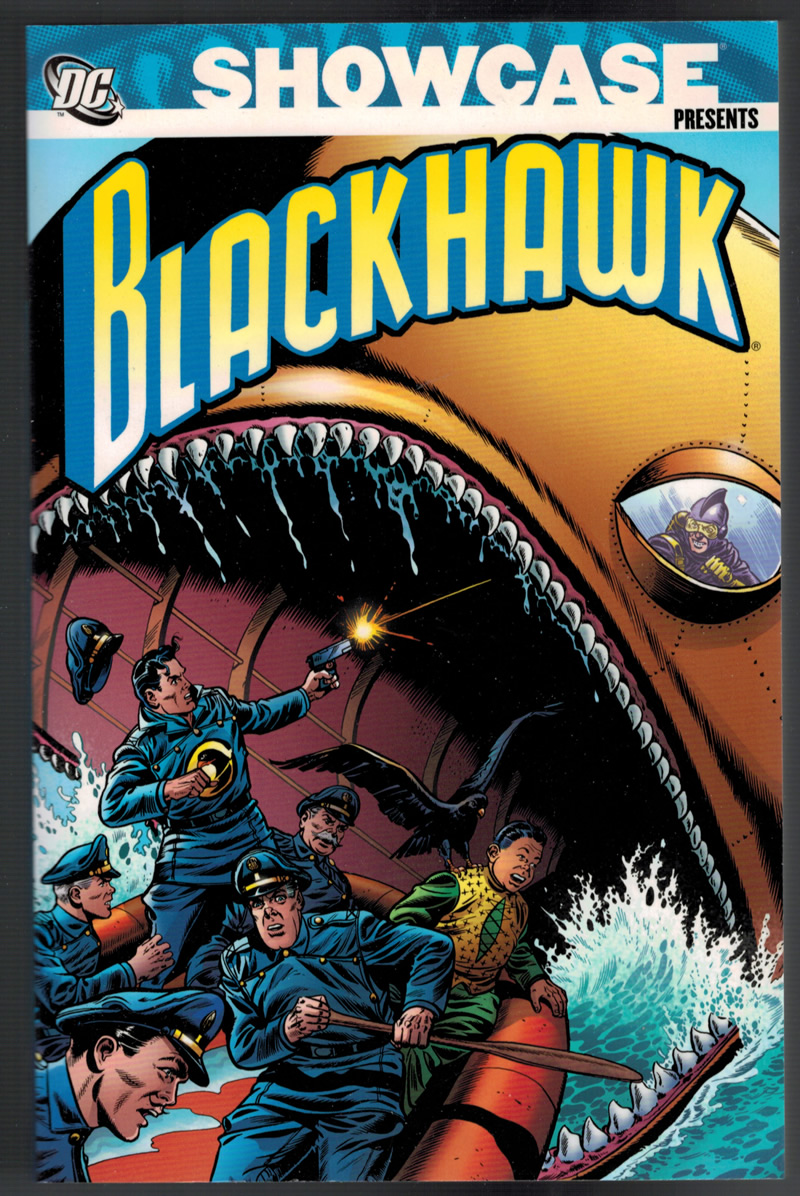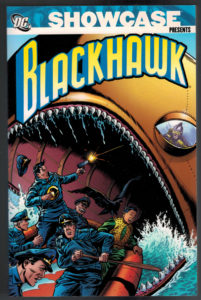Comic Book Review: Showcase Presents: Blackhawk Volume 1 art by Dick Dillin and Charles Cuidero
In September 1939, Poland was invaded by Germany and the Soviet Union. The valiant Polish people battled bravely against the two-pronged attack, but it was to no avail. One aviator was shot down, as it happens, near his family’s farm, only to watch as it was blown to bits by a Nazi bomb. He discovered his siblings inside the ruined farmhouse, dead or dying. The aviator vowed vengeance against the Nazis, and particularly the pilot of the plane that had murdered his family, Captain von Tepp of the Butcher Squadron.
Months later in England, the aviator stewed in frustration. The RAF did not trust the Polish airmen who’d fled to their shores, thinking that because they’d lost, the Poles were inferior pilots. Unable to get in the air through the regular channels, the aviator found a small group of other pilots who were refugees (plus one American volunteer) and likewise unable to get into the fight. They pooled their resources and secretly purchased several Grumman XF5F Skyrockets, as well as supplies for them and a secret island base.
The aviator had discarded his civilian name and now went only by Blackhawk. His men were the Blackhawk Squadron, or just the Blackhawks. They operated on behalf of the Allies, but independently of any military command, striking wherever the need was greatest. After a few missions never detailed, Blackhawk and his men were able to track down von Tepp and Blackhawk took his revenge. His personal business complete, the Blackhawks were free to fly anywhere at any time to fight the Axis.
The Blackhawks first appeared in Military Comics #1 in 1941, under the Quality Comics label, and got their own title, Blackhawk, in 1944. They were very popular, at one point selling just below Superman. In 1952, they even got a film serial, starring Kirk Alyn, who’d previously played Superman in the movies.
But by 1957, sales were waning, and Quality first leased, then sold, its trademarked characters and titles to DC. Blackhawk was one of only a handful of titles to continue (the other notable one was G.I. Combat.) It kept its art team, but had an assortment of now-anonymous writers.
This volume reprints the DC run, starting with #108. At this point, the team had long been stabilized at seven members. Blackhawk (Polish/American/Polish-American) was the leader. Hendrickson (Dutch/German) was the team sharpshooter and the oldest member. Stanislaus (Polish) was generally the second-in-command–at this point he was said to have been a aerialist before the war and was quite acrobatic. Andre (French) was a mechanical engineer and a bit of a ladies’ man. Olaf (Swedish) was large and exceptionally strong. Chuck (American) was a radio specialist. And Chop-Chop (Chinese) was the team cook. We’ll get back to him.
Since the Korean War was over and Vietnam was not yet hot, the Blackhawks (now flying Lockheed XF-90 C jets) primarily fought spies, saboteurs and mechanized gangs. In the first couple of issues, their primary opponents are International Communism, the agents of whom are mostly pure evil (except the one woman who is won over by Blackhawk’s chivalrous behavior and moral rectitude.)
At a guess, these stories were left over from previous writers, as after that contemporary politics vanishes altogether, and much more time is spent on borderline to full science fiction plots. Lost civilizations, time travel, aliens, and lots and lots of robots and awesome vehicles. The team also acquired a pet between issues, a black hawk named Blackie who was of human intelligence (even able to tap out complex messages in Morse Code!)
The Blackhawks also ran into supervillains, most often a high-tech pirate calling himself Killer Shark or his marine-life themed minions. They even fought the first Mr. Freeze DC had.
The plots tended to be simple, as the stories were quite short and mostly meant for kids. There’s relatively little characterization, with each of the Blackhawks having just a few well-worn quirks.
And then there’s Chop-Chop (who did not even get a proper name until the 1980s!) It’s worth pointing out that even when he first appeared in the 1940s, Chop-Chop was exceptionally competent and good in a fight. But he was also clearly a comic relief character, short, round, and with facial features that look pretty darn racist towards Chinese people.
By 1957, this had been toned down considerably. His face was still stereotypical, but not really more so than say Olaf’s. He’d ditched the queue and lost weight, but still only came up to chest height on the other men and dressed in a “coolie” outfit that had been outdated even back in 1941.
The other Blackhawks treated Chop-Chop as an equal, and he remained good in a fight. But he also didn’t have his own plane (usually acting as navigator for Blackhawk) and sometimes gets left out of Blackhawks group activities. He’s also the sole Blackhawk to admit feeling fear, having the catchphrase “Wobbly woes!” In his one spotlight story, he’s held hostage for a time.
This was a relatively good depiction for a Chinese character in the comics of 1957-58, but sets the teeth on edge for modern readers.
Certain plot elements do get reused. There are no less than four times the Blackhawks fight counterpart teams! The first is the all-female Tigress Squadron. They don’t have a Chop-Chop or Blackie equivalent. At first Blackhawk tries to pitch that crimefighting is man’s work, but after they prove their competence, Blackhawk simply switches to criticizing their plan to execute a criminal mastermind instead of turning him over to the police. (In fairness to the Tigress Squadron, they’re entirely composed of the widows of men that criminal murdered after he escaped from the prison the Blackhawks delivered him to multiple times. They have good reason for wanting to make sure this time.)
Next up is the all-villain Crimson Vultures. They do have a Chop-Chop equivalent (who never does anything) as well as a crimson vulture named Crimson to fight Blackie. Unfortunately for them, Crimson is not as smart as Blackie, and that costs them the battle.
And two entirely separate miniature robot versions of the team created by mad inventors! (Both have a Chop-Chop but not a Blackie.)
Coordination between writers was plainly not a priority. In one story, a humanoid robot intelligent enough to infiltrate a criminal gang for months is brought back after several issues of being missing, and the Blackhawks take it back to their island. In the next issue, Blackhawk needs a humanoid robot for something, and builds one from scratch, without even mentioning the previous robot, who also does not appear again in this volume.
That said, there are some tremendous machines in this series, and the War Wheel is always a joy to see in action.
Primarily recommended to older fans who fondly remember the Blackhawks from their childhood like me. Others should take advantage of interlibrary loan.
And now, here’s a trailer for the Blackhawk serial! Hawk-aa!


